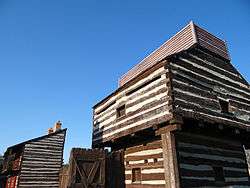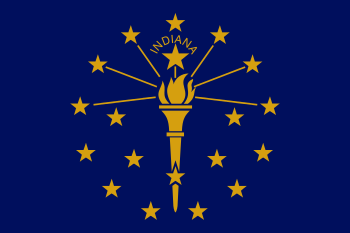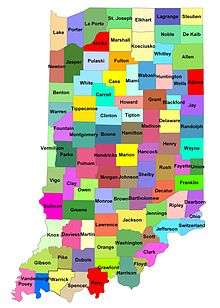Fort Wayne (fort)

Coordinates: 41°5′7.91″N 85°8′10.78″W / 41.0855306°N 85.1363278°W Fort Wayne in modern Fort Wayne, Indiana, was established by Captain Jean François Hamtramck under orders from General "Mad" Anthony Wayne as part of the campaign against the Indians of the area. It was named after General Wayne, who was victorious at the Battle of Fallen Timbers. Wayne may have chosen the name himself—the fort was dedicated the day after he left it. The fort was officially occupied by the army on October 21, 1794. The fort was a basic stockade with few buildings, and was located near the present intersection of Berry and Clay streets.
History
Fort Wayne was the successor of several previous military outposts at the location. Jean Baptiste Bissot, Sieur de Vincennes built the first fortified trading post on the site in 1704 called Fort Miami.[1]
Fort Wayne

Wayne's Legion arrived at Kekionga on 17 September 1794, and Wayne personally selected the site for the new U.S. fort.[2] Wayne wanted a strong fort built, capable of withstanding not only an Indian uprising, but a possible attack by the British from Fort Detroit. The fort was finished by 17 October, and was capable of withstanding 24-pound cannons.[3] It was named Fort Wayne and placed under command of Major Jean François Hamtramck, who had been commandant of Fort Knox in Vincennes. The fort was officially dedicated 22 October[3] (the fourth anniversary of Harmar's Defeat), and the day is considered the founding of the modern city of Fort Wayne.[4]
The garrison at Fort Wayne normally consisted of about 100 men and their families.[5] In 1796, the garrison was ordered to march down the Maumee River to counteract a British demonstration. The force received the transfer of Fort Miami from the British before Colonel Hamtramck was transferred to Fort Detroit - later the site of another Fort Wayne, and near the future town of Hamtramck, Michigan. Colonel David Strong, a veteran of the American Revolution and Wayne's Legion, succeeded him as commandant of Fort Wayne for two years,[6] before transferring commands with Colonel Hamtramck in 1798.
Colonel Thomas Hunt—a veteran of the Battles of Lexington and Concord, Bunker Hill, and Wayne's Legion—took command of the fort on 16 May 1798,[7] and built a substantial new fort several hundred yards north of the original, near the modern city's Old Fort Park. The new fort contained multiple guard houses and Indian "factories" (trading posts). The first fort was demolished about 1800.
During the War of 1812, Fort Dearborn (in present Chicago) was evacuated and the residents tried to reach Fort Wayne, but were massacred before they arrived. Fort Wayne was next besieged by the Indian forces of Tecumseh during the Siege of Fort Wayne.[8] Captain James Rhea was in charge of the fort and considered surrendering the fort, but his two lieutenants relieved him of duty. General William Henry Harrison arrived on September 12, 1812 and broke the siege. Captain Rhea was formally relieved of duty and one of the lieutenants, named Ostrander, was given official command of the fort.
After the war, a town began growing around the fort. A third fort was built in 1816 by Major John Whistler. The fort was officially abandoned on April 19, 1819, and its contents shipped to Fort Detroit.
Commanders of Fort Wayne
| Colonel John Hamtramck | ||
| Colonel David Strong | 1796–1798 | Transferred with Second American Regiment to Fort Lernoult |
| Colonel John Hamtramck | 1798 | Transferred back to Fort Lernoult. His son, John Francis Hamtramck, was born in Fort Wayne during this year, and is sometimes considered the first U.S. citizen born in Fort Wayne.[7] |
| Colonel Thomas Hunt | 1798–1802 | Built new fort in 1800 |
| Captain Thomas Pasteur | 1802 | Former commandant of Fort Knox and Fort Massac. |
| Colonel Henry Burbeck | 1803 | |
| Major Zebulon Pike | 1803 | Father of explorer.[9] |
| Captain John Whipple | 1803–1807 | In command during Quaker Agriculture missions to the Miami.[9] |
| Captain Nathan Heald | 1807–1810 | Married Rebeckah Wells, niece of William Wells. Transferred to Fort Dearborn (Illinois) |
| Captain James Rhea | 1810–1812 | Commander during the Siege of Fort Wayne |
| Lieutenant Ostrander | 1812 | Relieved Capt. Rhea of command during the Siege of Fort Wayne
Later arrested by Capt Moore, and died 13 July 1813, while in captivity.[10] |
| Captain Hugh Moore | 1812–1813 | |
| Major Joseph Jenkinson | 1813[11] | Assumed command after commanding flotilla of supply boats to Fort Wayne.[12] |
| Major John Whistler | 1814–1817 | Was a British soldier at the Battles of Saratoga. Had been with Wayne's legion and helped build original Fort Wayne. Also built first Fort Dearborn, where he served as the first commandant.[11] Built third Fort Wayne in 1815.[13] Transferred to St. Louis. |
| Lieutenant Daniel Curtis | 1817 | Was at Siege of Fort Wayne. Served 3 months as temporary commandant.[14] |
| Major Josiah N. Vose | 1817–1819 | Last commandant of Fort Wayne. Garrison abandoned fort 19 April 1819.[15] |
Notes
- ↑ "Vincennes, Sieur de (Jean Baptiste Bissot)," The Encyclopedia Americana (Danbury, CT: Grolier, 1990), 28:130.
- ↑ Poinsatte, 27
- 1 2 Poinsatte, 28
- ↑ Fort Wayne: History
- ↑ Poinsatte, 32
- ↑ Poinsatte, 33
- 1 2 Poinsatte, 37
- ↑ Fort Wayne history
- 1 2 Poinsatte, 38
- ↑ Poinsatte, 71
- 1 2 Poinsatte, 73
- ↑ Allison, 229
- ↑ Poinsatte, 76
- ↑ Poinsatte, 80
- ↑ Poinsatte, 81
- Allison, Harold (©1986, Harold Allison). The Tragic Saga of the Indiana Indians. Turner Publishing Company, Paducah. ISBN 0-938021-07-9. Check date values in:
|date=(help) - Poinsatte, Charles (1976). Outpost in the Wilderness: Fort Wayne, 1706-1828. Allen County, Fort Wayne Historical Society.


